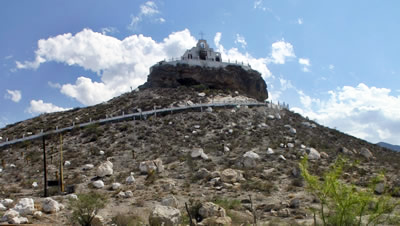Parras, Coahuila, The Site of America's First Vineyard
- Last Updated: April 18, 2023 by Al Barrus
- Categories:
- Coahuila, Destinations, Wine
 When I think of American vineyards, Napa Valley is the place that comes to mind. However, I recently discovered that here in my home state of Coahuila in northeast Mexico, resides the oldest winery in the Americas. And it's just a couple hours west of where I live in Saltillo.
When I think of American vineyards, Napa Valley is the place that comes to mind. However, I recently discovered that here in my home state of Coahuila in northeast Mexico, resides the oldest winery in the Americas. And it's just a couple hours west of where I live in Saltillo.
The decision to make the day trip was on a whim; the wife and I decided we could use a mini-vacation so we packed a few things in the car and headed for Parras de la Fuente, which is the municipality west of Saltillo. I had heard tell of the natural waters of Parras, which is apparent by its name that translates to Grapevines of the Fountain.
When we first arrived I could tell there was something special about this place because of all the verdant growth. I had never seen vineyards in Mexico. There are also peach and pecan orchards among the fields of green. It's also called Coahuila's Oasis. That much green really stands out after hours of driving in the high desert steppe of this part of Mexico.
At the entrance to the city there was a big sign saying welcome in Spanish, English, Italian and Chinese. The sign also called the city Pueblo Magico or magic town. The thing that makes it magical is its natural spring waters. That's why it's so green, and also why it's the site of the first winery of the Americas, founded in 1597, which is also when the Jesuit Father Juan Agustin established a mission there.
When I arrived with my wife we were simply happy to be among the green of an oasis. The city itself is very quaint, with few of the big city frills and services. I was able to use my phone's 3G internet to find information on the city's tourist attractions, however the address and GPS guidance didn't seem to get us anywhere and we found ourselves asking random people where to find some of the magic town's diversions.
 We went from one end of the town to the other. A kind stranger named Mario offered to ride with us to be our guide to see the natural spring wells. Mario led us to the site of the Estanque de La Luz, or pond of light; however it was closed to the public. I did get to see the stream emanating from the cavernous hole, almost by magic, since there's such little rainfall in this part of the world. The water from the spring goes into an aqueduct, reminiscent of Roman construction, which leads to the vineyards and orchards. Anyone is welcome to take a dip in the flowing magic water. I took a dip, that was the main reason I came there, and it was free.
We went from one end of the town to the other. A kind stranger named Mario offered to ride with us to be our guide to see the natural spring wells. Mario led us to the site of the Estanque de La Luz, or pond of light; however it was closed to the public. I did get to see the stream emanating from the cavernous hole, almost by magic, since there's such little rainfall in this part of the world. The water from the spring goes into an aqueduct, reminiscent of Roman construction, which leads to the vineyards and orchards. Anyone is welcome to take a dip in the flowing magic water. I took a dip, that was the main reason I came there, and it was free.
Mario also showed us where to find the city's principal church, Iglesia de Santo Madero, which sits upon a giant rock that overlooks the town. When we dropped Mario off at his home we offered him some money for his time, and he refused even after we insisted. It was a surprise to me because in cities it's assumed you will pay for that sort of service, but that's just a reflection of how genuinely kind and helpful the people are in Mexico, especially in the pueblos.
 As far as other tourist activities go, there was also a water park there, but it was dried up and being cleaned at the time. I can't tell you when it's in service because no one seemed to know. However when you enter the city there's a great tourist locale called Casa Madero, which is home to the old winery and it's also a museum of the revolution. There are also some fancy hotels which were converted from the homes of the city's founders.
As far as other tourist activities go, there was also a water park there, but it was dried up and being cleaned at the time. I can't tell you when it's in service because no one seemed to know. However when you enter the city there's a great tourist locale called Casa Madero, which is home to the old winery and it's also a museum of the revolution. There are also some fancy hotels which were converted from the homes of the city's founders.
With my pregnant wife in tow we couldn't hike up to see the inside of the church, or partake in the wine tastings, but if there's one great place in Mexico to do some wine tasting, it's in Parras de la Fuente, Coahuila.